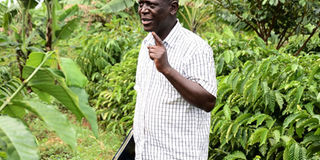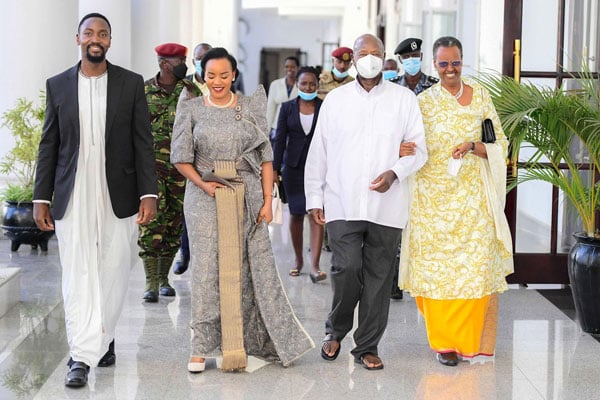Kitende headteacher counting on coffee

The St Mary’s Kitende headteacher has intercropped his coffee with banana. Photos | George Katongole
What you need to know:
- Managing a coffee plantation can be demanding. With schools currently under lockdown because of the Covid-19 pandemic, he finds time to supervise his two employees.
- As he sweats to keep his plantation in pristine condition, he has to keep fighting against the twig borer. The black coffee twig borer, an increasingly serious coffee pest, can be contained with chemicals. The pest kills coffee-bearing twigs/branches, leading to losses.
Everyone has his own recipe for getting money. In the case of St Mary’s Secondary School Kitende O-Level headteacher John Bosco Sebabi, teaching for more than 20 years has been a rewarding experience. He is now blending it with commercial coffee growing.
Journey into farming
Sebabi, a geography teacher, is one of the farmers who has been interested in adapting what is now known as the Brazilian model which is premised on planting coffee trees in a spacing of three by one metres.
National Union of Coffee Agribusinesses and Farm Enterprise (Nucafe) has been campaigning for the coffee planting spacing of Robusta to propel the increased coffee production to 20 million 60-kilogramme bags as government priority by 2025.
Sebabi is now dedicated to turning his three-acre land in Ngongolo, Kajjansi Town Council in Wakiso District, not only a demonstration farm but a goldmine.
Raised in a peasant family, Sebabi and the rest of his family members, survived on coffee for all basics where children were the major source of farm labour.
However, since graduating from university 23 years ago, he has been putting all his efforts on teaching instead of farming.
He had limited time for farming although he knows the tricks of the trade that were handed down to him from the family farming history.

Sebabi and wife take lessons from seasoned coffee farmer Nkandu. The Sebabi’s had gone to Masaka on a benchmarking mission.
Turning point
Sebabi had bought three acres of land at Shs37m in 2016 in Ngongolo but left it idle as he was not sure of what to do with it.
Neighbours always told him he could not make use of the land part of which was an abandoned stone quarry.
His Saul-to-Paul moment came in 2016 when he read a newspaper article in Seeds of Gold titled “Lessons from Brazil inspires a Ugandan experiment to increase coffee production,” which explained the novel system of growing coffee and he was excited at the prospect.
He contacted Joseph Nkandu, a family friend, for a farm visit on the new spacing he was advocating for in the newspaper.
He did not visit once but twice to overcome his fears. He was convinced that coffee extracts nutrients from the space instead of the sub-soil.
In September 2018, accompanied by his wife Margaret, they had an on-farm experience sharing with Nkandu at his demonstration farm at Bunjakko Island on the novel coffee farming.
In October, 2018, Nkandu, also executive director of Nucafe, interested him and the rest, as they say, is history.
He bought commercial grade 6 clonal seedlings from the National Agricultural Research Laboratories (NARL-Kawanda) and garden preparation started in August 2018.
He uses 2.5 acres for coffee planting with the remaining piece reserved for a piggery project that will supply manure.
Rocky start
A new challenge popped its ugly head when he started. The soil test, which had been recommended by Nkandu was disastrous.
Despite being a stone’s throw from the marsh overlooking the stretch of water that makes part of Entebbe Airport, the land was uncharacteristically infertile and subject to leaching.
For coffee plants to grow well, it requires a soil of good structure, permeable and deep. Yet his piece of land had shallow coarse soils.
“I was warned there was a lot of work to do in order to replenish the soil,” he says.
This involved applying a basinful of manure in each of the more than 3,000 holes that were planted with coffee on top of adding artificial fertilisers. The early planting days involved mulching and digging ridges aimed at curbing erosion. But he could not find a solution to the highly leached soils.
“I have to keep applying manure and other fertilisers,” he notes.
Management
In the traditional method, coffee trees are planted in a spacing of three by three metres which can lead to about 450 coffee trees per acre.
In the innovative Brazilian technique, however, coffee trees are planted in rows at spacing of one metre and the rows are three meters apart which can yield about 1,300 plants in an acre.
The method though is intense on fertilisation, watering and proper management of the canopy since the trees are so close to each other.
“Since these plants are so close to each other, they need a constant supply of water,” Sebabi explains.
To face the challenge, he has dug a well at the lower part of the farm where he pumps water into a tank and then releases it to the plants manually through several taps.
Managing a coffee plantation can be so demanding. With schools currently under lockdown because of the Covid-19 pandemic, he finds time to supervise his two employees.
Coffee trees are shallow-rooted, he says, which means that most feeder roots are near the surface. Weeding is a regular activity in order to minimise competition for both nutrients and water.
The nature of planting and continued occurrences of water shortage and extended droughts require irrigation. Even though Robusta coffee is drought tolerant, it responds well to irrigation.
Ronald Onyangai, a production officer with Nucafe, estimates that to irrigate one acre of coffee, up to a depth of one inch is required -- an estimated 85,000 litres.
“Artificial irrigation boosts productivity in dry periods,” Onyangai said.
A simple solar irrigation system can cost about Shs3.5m from retailers like Tulima Solar and Solar Now.
Sebabi is meeting the current financial demands by harvesting matooke plants which he intercropped in his coffee in 2018.
Optimism
The method is seen as revolutionary in terms of productivity per acre with Shs23m estimated to be reaped from just one acre planted with coffee.
Handfuls of picking from the two-year old plants have already yielded about 100 kilogrammes for Sebabi. Yet he remains modest about his expectations.
“If I can harvest a kilogramme from each tree, that would give me about three tonnes. That is not a bad output compared to the traditional way of growing coffee,” Sebabi explains.
Retirement package
After two decades in teaching, Sebabi thinks the emotional attachment he has with teaching will have to stop one day. Farming, therefore, is an optional activity.
“Farming has been good to us since it gave me a life. But first, I have to expand by getting more land. Teaching still needs me and I still have the energy but when that time comes, farming is what I want to do,” he says.
Challenges
As he sweats to keep his plantation in pristine condition, he has to keep fighting against the twig borer. The black coffee twig borer, an increasingly serious coffee pest, can be contained with chemicals. The pest kills coffee-bearing twigs/branches, leading to losses.
He controls it by spraying with striker, an insecticide that controls larval and adult stages of the pest. He was advised to cut the affected branches, though he considers it tiring.
In five years’ time, the farmer plans to increase his coffee plantation to 10 acres and also establish a coffee processing plant.




